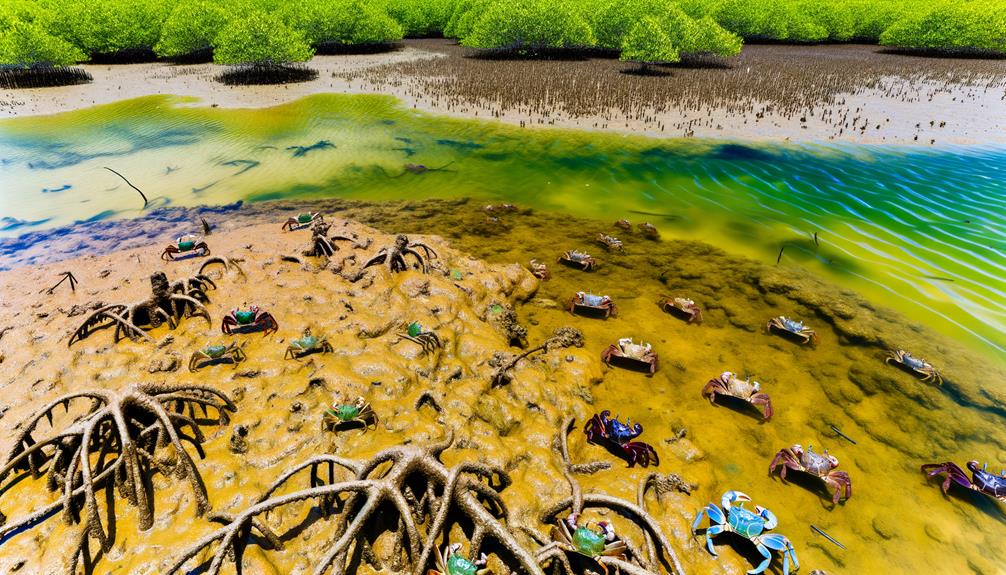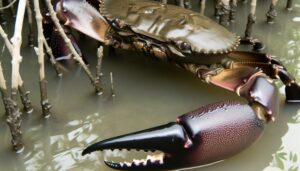Do Mud Crabs Prefer Freshwater or Saltwater Habitats?
Mud crabs primarily inhabit brackish and coastal marine environments, thriving in estuarine zones with varying salinity levels. They've honed advanced osmoregulatory mechanisms and specialized gills to adapt to both saltwater and freshwater conditions.
Species like *Scylla serrata* showcase adaptability with efficient ion-transport proteins and burrowing behaviors, aiding them in maintaining homeostasis. While often associated with mangrove swamps and tidal flats, their versatile nature allows them to inhabit freshwater areas.
Interested in understanding how these crabs sustain themselves across such diverse environments? Stay tuned for an exploration of their ecological adaptations and physiological mechanisms.

Key Takeaways
- Mud crabs are primarily found in brackish and coastal marine environments.
- They exhibit adaptability to varying salinity levels, including freshwater and saltwater.
- Specialized gill functions and ion-transport mechanisms aid in their osmoregulation.
- Mud crabs can maintain homeostasis in both low and high salinity environments.
- They are found in estuarine zones, mangrove swamps, and river deltas.
Habitat Overview
Mud crabs, primarily found in both brackish and coastal marine environments, exhibit a remarkable adaptability to varying salinity levels. You'll notice these crustaceans thrive in estuarine zones where freshwater rivers meet the ocean.
Their physiological mechanisms, such as osmoregulation, allow them to maintain homeostasis despite fluctuating salinity. They burrow in soft substrates like mud or sand, providing both shelter and a hunting ground for prey.
Tidal movements play a vital role in their habitat, influencing feeding patterns and reproductive cycles. By understanding their habitat preferences, you can appreciate how mud crabs exploit diverse ecological niches.
They're not strictly freshwater or saltwater dwellers; their habitat spans a dynamic interface between these environments, showcasing their ecological versatility.
Species Classification
Understanding the diverse habitats of these crustaceans leads us to examine the different species classifications within the mud crab family, specifically within the genus Scylla.
You'll find four primary species: Scylla serrata, Scylla olivacea, Scylla paramamosain, and Scylla tranquebarica. Each species exhibits unique morphological traits and ecological preferences.
Scylla serrata, commonly known as the giant mud crab, thrives in estuarine environments, while Scylla olivacea prefers mangrove swamps. Distinguishing between these species involves analyzing carapace patterns, claw morphology, and genetic markers.
Accurate classification aids in understanding their ecological roles and informs sustainable management practices. By grasping these distinctions, you can better appreciate the complexity and adaptability of mud crabs within their varied aquatic habitats.
Geographic Distribution
Across various regions of the Indo-Pacific, the genus Scylla exhibits a widespread distribution, occupying a range of habitats from the warm coastal waters of Southeast Asia to the estuarine zones of Australia. You'll find these mud crabs mainly in mangrove swamps, tidal flats, and river deltas, where saline and brackish water conditions prevail.
Their adaptability to different salinity levels allows them to thrive in both estuarine and marine environments. The species Scylla serrata, commonly known as the giant mud crab, is especially common in these areas. This broad geographic distribution is facilitated by their larval dispersal mechanisms, which are influenced by ocean currents and tides, promoting genetic diversity and population resilience across vast distances.
Lifecycle Stages
Remarkably, the lifecycle of Scylla species encompasses several distinct stages, each characterized by unique physiological and ecological adaptations.
You'll find that mud crabs start as tiny zoea larvae, which drift in plankton-rich waters. They metamorphose into megalopa, displaying more crab-like features, and then settle in estuarine environments. As juveniles, they grow rapidly, molting frequently to accommodate their expanding size. This stage is essential for their development and survival.
Upon reaching adulthood, mud crabs migrate to deeper waters for reproduction. Females release eggs, which hatch into zoea, completing the cycle. Each stage demands specific conditions and resources, showcasing their remarkable adaptability and resilience.
Understanding these stages is key to effective conservation and aquaculture practices.
Environmental Preferences
When considering mud crabs' environmental preferences, you need to examine their ideal habitat conditions, salinity tolerance levels, and temperature range preferences.
Mud crabs thrive in estuarine and coastal environments where salinity varies, demonstrating remarkable osmoregulatory capabilities.
Additionally, they prefer temperatures between 20-30°C, which has a notable impact on their metabolic and physiological processes.
Ideal Habitat Conditions
Mud crabs thrive best in brackish water environments where salinity levels fluctuate between 15 to 25 parts per thousand, providing a mix of freshwater and saltwater conditions. In these habitats, you'll find them in estuaries, mangroves, and tidal flats. These areas offer a diverse range of microhabitats that cater to their physiological and ecological needs.
Mud crabs prefer substrates like mud and sand, which facilitate their burrowing behavior and offer protection from predators. Additionally, the presence of organic matter and detritus in these environments serves as an optimal food source. By maintaining ideal temperature ranges between 24°C to 30°C and ensuring dissolved oxygen levels are above 4 mg/L, you can create ideal conditions for their growth and survival.
Salinity Tolerance Levels
Salinity tolerance levels in mud crabs exhibit significant variability, accommodating a wide range of environmental conditions from estuarine brackish waters to more saline marine environments.
You'll find that mud crabs, particularly species like *Scylla serrata*, can endure salinity fluctuations between 5 to 35 parts per thousand (ppt).
This adaptability is due to their osmoregulatory capabilities, allowing them to maintain internal homeostasis despite external changes.
Juveniles often prefer lower salinity zones, while adults can thrive in higher salinity areas.
When monitoring mud crab populations, consider how their salinity tolerance influences their distribution and behavior.
Understanding these levels is pivotal for effective aquaculture practices and environmental management, ensuring the health and sustainability of mud crab habitats.
Temperature Range Preferences
In addition to their salinity tolerance, mud crabs exhibit specific temperature range preferences that greatly impact their physiological processes and habitat distribution. You'll find that mud crabs thrive in water temperatures between 20°C and 30°C. Best-fit temperatures support their metabolism, growth, and reproductive cycles.
- Metabolic Rate: Mud crabs' metabolic rates are temperature-dependent, peaking within the 25°C to 28°C range, which enhances their energy efficiency.
- Growth Rates: Larval and juvenile crabs experience accelerated growth rates within the 24°C to 29°C range, essential for their survival and development.
- Reproductive Success: Successful mating and egg development occur most efficiently at temperatures around 26°C to 28°C, ensuring population stability.
Understanding these preferences helps you predict their distribution and manage their habitats more effectively.
Salinity Tolerance
You'll find that mud crabs exhibit remarkable adaptation to varying salinity levels, showcasing their euryhaline nature. These crabs can thrive in both freshwater and saltwater environments, depending on their species and life stage.
Adaptation to Salinity
Mud crabs exhibit remarkable physiological adaptations that enable them to thrive across a spectrum of salinity levels. You'll appreciate how their osmoregulatory mechanisms maintain internal homeostasis. They regulate ion concentration and water balance through specialized gill structures.
Here's a closer look:
- Ion Transport Proteins: These proteins actively pump ions in and out of cells, adjusting to varying salinity.
- Gills Adaptations: Their gills contain specialized cells that facilitate efficient ion exchange and water balance.
- Behavioral Adjustments: Mud crabs can move between different salinity zones to optimize their physiological processes.
Understanding these adaptations clarifies how mud crabs survive in both freshwater and saltwater environments, showcasing their evolutionary resilience and ecological versatility.
Habitat Variability
Astonishingly, mud crabs exhibit significant tolerance to a wide range of salinity levels, allowing them to inhabit diverse aquatic environments from brackish estuaries to freshwater rivers.
You'll find that their osmoregulatory capabilities enable them to maintain internal homeostasis despite fluctuating external salinity. This adaptability is facilitated by specialized gill functions and ion-transport mechanisms, ensuring they thrive in both saline and freshwater conditions.
Understanding this, you can appreciate how mud crabs exploit various habitats for foraging and breeding. Their broad salinity tolerance also underscores their ecological resilience and adaptability, making them a key species in estuarine ecosystems.
Adaptations to Habitat
The physiological adaptations of mud crabs allow them to thrive in both freshwater and saltwater environments by efficiently regulating their osmoregulatory mechanisms. You're probably curious about how they do it. Here are three key adaptations:
- Ion Transport Proteins: Mud crabs possess specialized proteins in their gills that actively transport ions, helping them maintain internal ion balance despite external salinity changes.
- Excretory System Adaptations: Their excretory systems are highly efficient at expelling excess salts in saltwater environments while conserving salts in freshwater habitats.
- Behavioral Adaptations: They often burrow into the substrate to avoid extreme salinity fluctuations, thereby stabilizing their internal environment.
These adaptations ensure mud crabs maintain homeostasis, allowing them to inhabit diverse aquatic ecosystems without compromising their physiological integrity.
Freshwater Populations
Freshwater populations of mud crabs exhibit unique physiological traits that enable them to efficiently osmoregulate in low-salinity environments. You'll find these crabs possess specialized gills and ion-transport mechanisms that adapt to fluctuating freshwater conditions. Let's break down some key differences between freshwater and saltwater mud crabs:
| Trait | Freshwater Mud Crabs |
|---|---|
| Osmoregulation Mechanism | Specialized gill function |
| Ion Transport | Enhanced ion uptake |
| Salinity Tolerance | Low to moderate |
| Habitat | Rivers, estuaries |
| Physiological Adaptation | Efficient osmoregulation |
Understanding these traits helps you appreciate the complexity of mud crabs' adaptability. Their ability to thrive in low-salinity environments showcases their evolutionary advances, making them fascinating subjects of study in comparative physiology.
Saltwater Populations
Shifting focus to saltwater populations, these mud crabs exhibit distinct physiological adaptations that enable them to thrive in high-salinity environments. You'll find that their osmoregulatory mechanisms are finely tuned to maintain internal ionic balance.
Here are three key adaptations:
- Ion Transport Proteins: Specialized proteins in their gill membranes actively transport ions, ensuring stable internal conditions.
- Exoskeleton Composition: Their exoskeletons contain higher concentrations of calcium, providing enhanced structural integrity in saline waters.
- Hemolymph Regulation: They regulate hemolymph (crab blood) osmolarity to match the surrounding seawater, reducing osmotic stress.
These adaptations not only support survival but also optimize their physiological performance, making saltwater habitats a viable environment for these resilient creatures. Understanding these mechanisms offers deeper insight into their ecological success in marine settings.
Brackish Water Zones
You'll find that mud crabs thrive in brackish water zones, which offer a unique mix of saline and freshwater conditions.
Their osmoregulatory adaptations allow them to maintain homeostasis despite fluctuating salinity levels.
This habitat preference enhances their survival and reproductive success in estuarine environments.
Habitat Preferences
Mud crabs exhibit a strong preference for brackish water zones where salinity levels fluctuate, allowing them to thrive in these shifting habitats. In these environments, mud crabs effectively navigate varying salinity, temperature, and oxygen levels, demonstrating their adaptability.
Their habitat preferences include:
- Mangrove Swamps: These areas provide abundant food sources and shelter, essential for their development.
- Estuarine Environments: In-between zones between river and sea offer an ideal mix of fresh and saltwater.
- Tidal Flats: These regions boast nutrient-rich mud, aiding in feeding and burrowing activities.
You'll find mud crabs in these specific habitats due to their ability to exploit the ecological niches available, ensuring their survival and reproductive success in brackish water zones.
Survival Adaptations
In brackish water zones, mud crabs exhibit specialized physiological adjustments to maintain homeostasis despite fluctuating salinity levels. Their ability to regulate internal ion concentration is essential for survival. Osmoregulation involves active transport mechanisms in their gills, allowing them to control the uptake and expulsion of salts.
Their gills are also structurally adapted with ion-transporting cells, effectively managing the ionic balance in varying salinities. Mud crabs can alter their metabolic rates to conserve energy when salinity changes. This adaptability guarantees they thrive in estuarine environments, where freshwater meets seawater, showcasing their resilience in challenging habitats.
Understanding these adjustments highlights the complexity and efficiency of their survival strategies.
Farming Practices
Effective farming practices for mud crabs hinge on maintaining ideal salinity levels to maximize their health and growth. You need to make sure the water salinity is between 15-25 ppt (parts per thousand). This range supports best osmoregulation and reduces stress.
Here's a step-by-step guide:
- Water Quality Monitoring: Regularly test water for salinity, pH, and dissolved oxygen. Stability in these parameters is essential for crab survival.
- Feeding Regimen: Provide a balanced diet rich in proteins and essential minerals. Overfeeding can deteriorate water quality.
- Disease Management: Implement biosecurity measures to prevent infections. Quarantine new stock and regularly check for signs of disease.
Conservation Efforts
To ensure the sustainability of mud crab populations, it's essential to implement strong conservation efforts that safeguard their natural habitats and genetic diversity.
You should prioritize habitat protection by restricting mangrove deforestation, which directly impacts the crabs' breeding grounds.
Enforcing sustainable fishing regulations, such as size limits and seasonal bans, helps prevent overharvesting.
Genetic diversity can be maintained through controlled breeding programs that avoid inbreeding and promote healthy populations.
Additionally, monitoring water quality parameters like salinity and temperature is optimal for maintaining best living conditions.
Engaging local communities in conservation initiatives ensures compliance and fosters a stewardship mindset.
Common Misconceptions
A common misconception about mud crabs is that they can only thrive in saltwater environments. However, these crustaceans exhibit remarkable adaptability to various salinity levels.
Scientifically, mud crabs (genus *Scylla*) are euryhaline species, meaning they can tolerate a wide range of salinities. Let's debunk three common myths:
- Exclusively Marine: Mud crabs can survive in brackish and even freshwater habitats.
- Limited Breeding: They can reproduce in both high and low salinity conditions.
- Nutritional Deficiency: They obtain essential minerals from diverse environments, maintaining their physiological functions.
Understanding these facts will help you appreciate the ecological versatility and resilience of mud crabs, challenging the belief that they're strictly bound to saltwater.
Conclusion
To sum up, mud crabs display intriguing adaptability, flourishing in both brackish and saltwater environments. Impressively, they can withstand salinity levels ranging from 15 to 30 parts per thousand, highlighting their exceptional ecological versatility.
You've delved into their habitat, lifecycle, and environmental preferences, gaining understanding of their resilience and importance in aquaculture. As you reflect on these details, keep in mind that effective conservation efforts are vital for preserving their populations and promoting sustainable farming practices.






